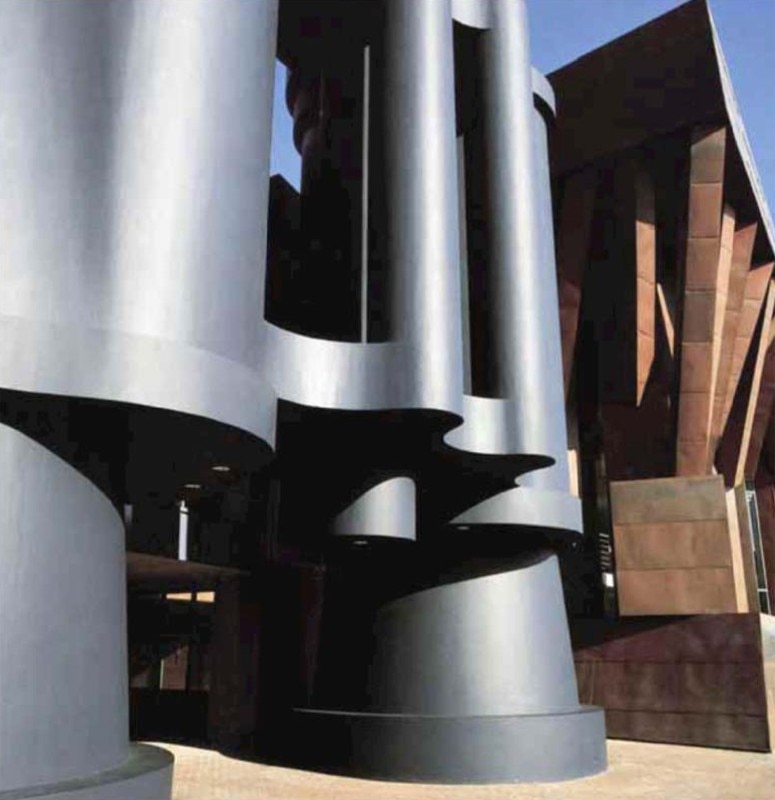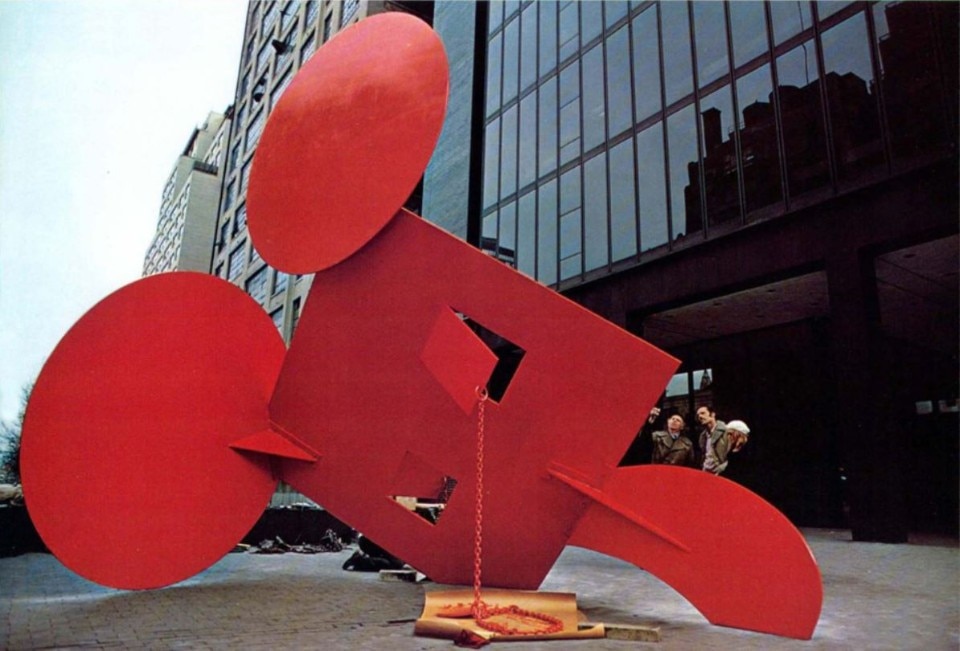Giant binoculars, cherries, slices of cake, electric plugs, threads and needles and American flags stretched to the scale of buildings and placed amidst other buildings: augmented reality in the literal sense of the term – enhanced reality might be more correct – is the hallmark of the work of Swedish-US artist Claes Oldenburg, who died on 18 July, while still developing a career rooted in the pop provocations of the 60s. And it is precisely of Pop Art and postmodernism that his work – developed since the 1970s with his wife Coosje Van Bruggen – on the monumentalisation of everyday consumerism objects has become iconic, a part of urban architecture most of the times, as it happened in his collaboration with Frank O. Gehry, or in the Milanese installations with Gae Aulenti. In April 1975, in a long conversation with David Shapiro, Oldenburg took the readers in a deep dive into the world of his ambiguously scaled objects, created “to establish communication”. Domus published this interview on issue 575.
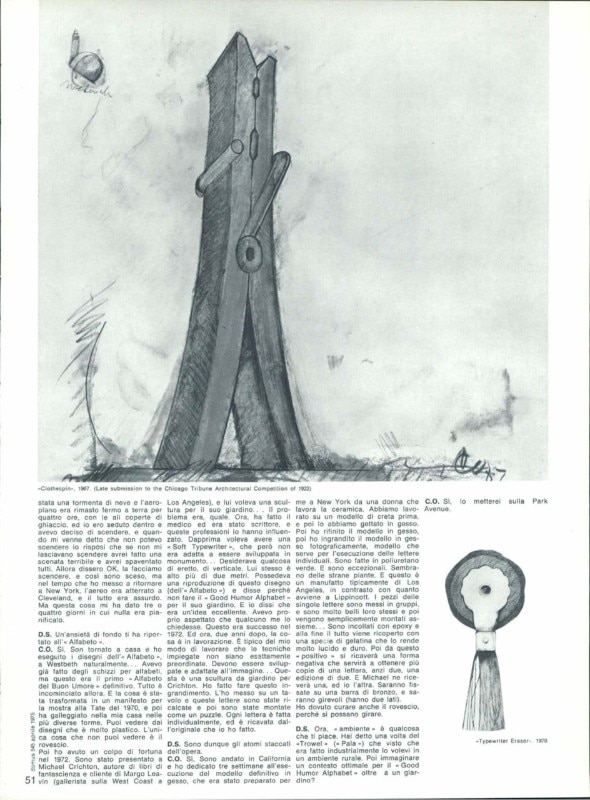
From an interview with Claes Oldenburg
David Shapiro:
Do you have Shakespearean confidence that your proposals, monuments, will survive?
Claes Oldenburg:
No, I don't. I think the only thing that survives is a drawing. I think monuments are bound to decompose. Ruins, I was thinking of doing ruins. That might be a new theme. Like the eighteenth century made cottages and stuff like that. It’s one of those frightening things like sex, you now, it's one that you don’t just jump into, but I've been thinking about it for some time. «The Clothespin » is a very romantic monument, I mean it’s almost like a tower. It’s going up in Philadelphia, I hope, next year. Four storey clothespin, forty foot.
D.S. What do you think of David Smith's involuntarily stripped sculptures? Painted sculptures?
C.O. I think Smith set up a situation where things were bound to deteriorate. Probably the most perishable thing paradoxically is an outdoor sculpture... A white lipstick would be a lot of fun, provided you also have one in color. I do the « ghost » versions which are white versions of the other things which are colored.
D.S. You don’t long for « purity » as you've said repeatedly.
C.O Sure, now and then. I mean, purity is just part of the repertoire of things one can long for. The notion of art as a single thing is dying.
D.S. Any possibility that like Schwitters’ your structures could be living spaces? Many of your proposals are architectural in the sense of being sepulchral structures.
C.O. I always think of the insides of the structures, that is, I never neglect the inside of a structure. If I have a three-way plug in my hand I am always thinking about what it looks like inside. I am always thinking about what it would look like enlarged, as if I was an ant or something. Being inside would be like a building. That's very important... One aspect of the plug is its easy translatability into, for example, a house, a cave, a living space.
D.S. Any possible practical commissions yet for a convincing living space?
C.O Not yet but I think that that's the way it’s all going. I think that architecture is going in that direction.
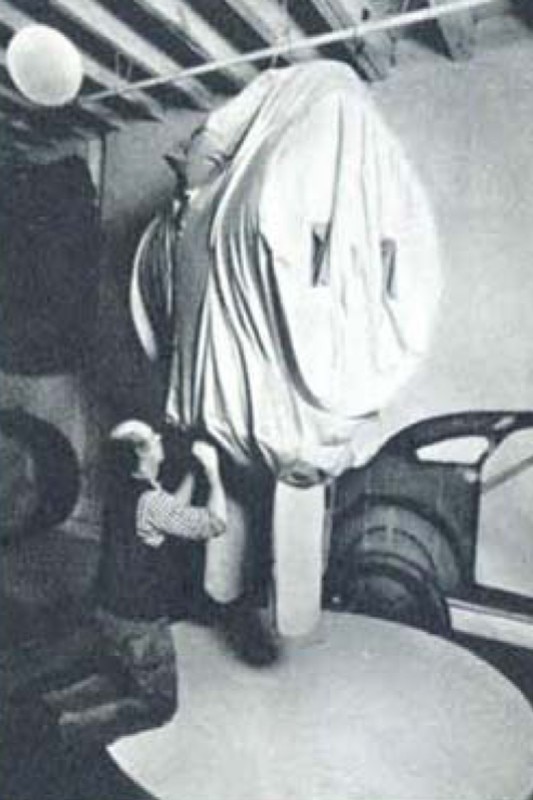
D.S. So we’d have a playful architecture, an erotic architecture, an architecture as “complex” as the Venturis' seem to want?
C.O Right. Now and then you go around the country and see someone has built something in that direction and carried it a little bit further.
D.S. In “Mitt and Ball” is your drive for a comical juxtaposition, Freudian condensations?
C.O. The “Mitt and Ball”. It depends on what people bring to it, too. There are two levels of language. There is my level which is a very personal level, which takes quite alot of experience to get into and then, there’s the conventional level. If people talk in terms of a mitt they’re seeing something different than what I’ve given them... Humor makes life tolerable and it’s terribly important, whatever humor is; it’s hard to define. There’s a danger always in humor, I suppose, that that’s what people who are humorless are afraid of — is that there's a danger that humor dissolves seriousness entirely...
D.S Are your new works transformations always of given objects?
C.O. Not really transformations. I don’t really transform to that degree. I simplify or I’ve reduced the form to an essential structure, which is a type of transformation. D.S. For example, if I gave you a water tower, how would you work on it?
C.O. Well, I'd probably strip it down and analyze the proportions and perhaps change the proportions a little bit based on other water towers I know. Then I’d have it sitting around and wait for an occasion to arise... I’d elongate it or I might compress it, whatever. The whole object would be subjected to analysis. I'd ask what's inside it... I’d ask what it’s made of. The question of substitution of material is very important, of course... I could make it in soft materials and that substitution, the act of substitution, would change its character in a very literal way... Softening has nothing to do with dream material for me.
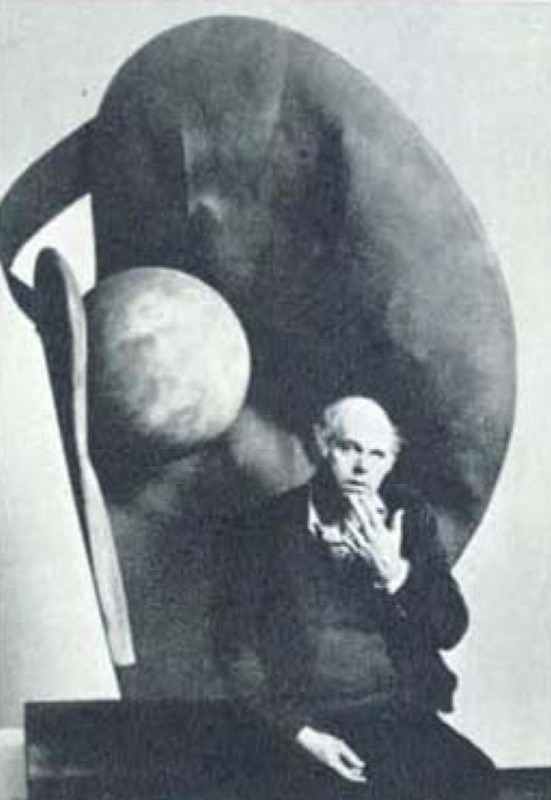
D.S T. S. Eliot spoke of the difficulty of development in an artist. Do you sense new work developing?
C.O Well, the work is a lot about development. It’s also about the same structure in different contexts and different situations like they get larger or they change materials. In fact, that’s what I’m doing a show for the Walker Art Center about the evolution of certain structures and how they change in the work. We’re taking six themes, six subjects, and showing how they change. The biggest thing in my life in the last couple of years has been the fabrication at the Lippincott Factory and getting into a sort of scale I haven’t had before which is in the area of twenty-four to forty feet. Making objects on a large scale in metal mostly.
D.S How do you feel now concerning problems of scale?
C.O Back when I started the Colossal Monuments, which were done originally as a cover for Domus. Those were, of course, fantasies and more like poems, impossible, though someday they may be possible. It’s conceivable. But they, at that time, were impossible. Now after a few years of that I started to think about just enlarging the objects I normally work with... “Monuments” is an ironic term. I used “monuments” in two ways: one, ironically (as to say, anti-monument) and also I used them for scale purposes, because when you say monument you think of something large, but the things that I'm doing, enlarging the objects, I don’t think of them as monuments necessarily... And I’m also collecting small objects. Take the Mouse Museum — the Mouse is a study in scale. They go by ears — the eighteen foot mouse has a nine foot ear and the smallest mouse has a six inch ear.
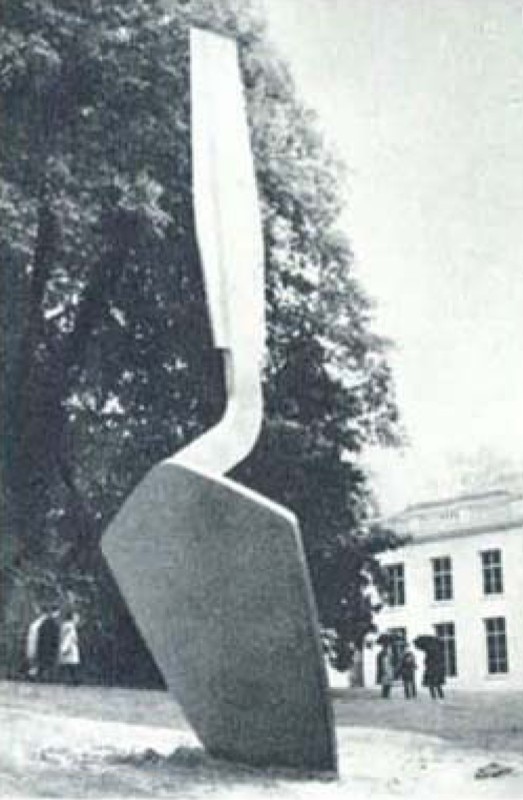
D.S Is the Alphabet a new palette of images for you?
C.O. No, the “Q” is probably the newest image, and I’m thinking about introducing a bone, but that’s also an alphabetical thing (it’s almost like the letter “I”). I’m interested in letter forms, always have been. Take this thing here (“The Good Humor Alphabet”) you do have the twenty-six letters. I’ve eliminated a couple of the letters because they didn't fit, but you can do that with the alphabet and not feel you’ve really lost anything so you throw out the “R”... It’s the alphabet in the form of a popsicle, the American popsicle, Good Humor type. This has a bronze stick on it. The whole thing is like an Indian sculpture full of writhing forms. It’s going to be very large and very, very physical. I don't even quite understand what I do with letters and the alphabet, but it's more than just taking a given... This is my poetry, and it has a lot to do with sound, with the representation of sound the way they do it in comics, with balloons and expressive sounds, so that’s part of it, the formulation of these things. It’s an attempt to make words and to make letters tangible.
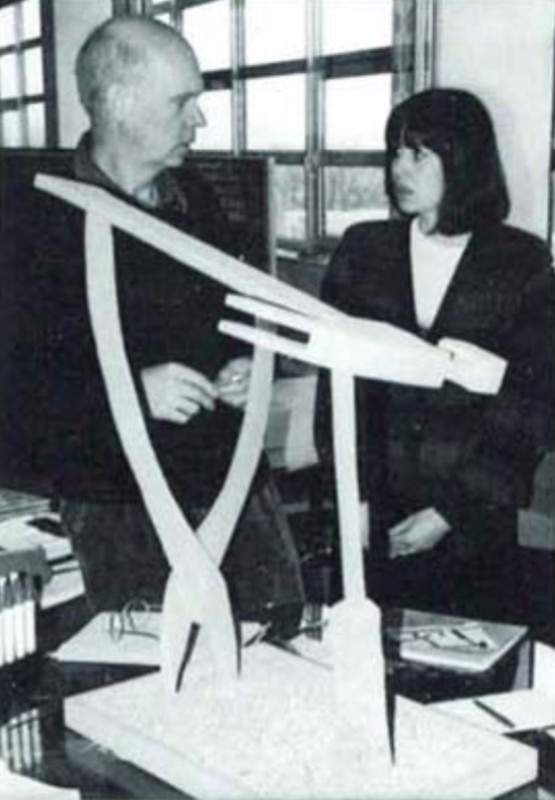
D.S. How do you refuse repetition in your work, or do you accept its compulsions?
C.O I like the idea of repetition and variation. This has never been a problem. I think the problem is more limiting things to certain forms and structures that are the most reductive and revealing, the simplest forms, the most expansive as well. So that I have notebooks full of projects. .. I tend to narrow down to about ten or twelve different subjects. .. Each one is sort of a family, like there’s the “Q” family which has to do with a circle and a tail going off of it. The circle and the tail is a whole family of forms, which you can find in the clothespin, or in the typewriter eraser. There are certain families of structures that I tend to do variations on.
D.S Wordsworth's epic subject was his own mentality, and yours?
C.O. Oh definitely, extremely diaristic. I keep a diary of all events and try to keep up and when I go somewhere I always reread the portion about that place... One of the things that I’ve been doing, this may be new, I've been kind of making an aesthetic activity out of planning for the future.
D.S. And the conceptualist puritanism concerning “objects”?
C.O I don’t treasure objects. I simply create objects to establish communication. So that I give you something and you take it and you set a value on it if it becomes even more important to you and then you give it to someone else. Money is very interesting. To become an artist you almost have to have a money value attached to an object that you've made otherwise you don’t exist as an artist; people won’t recognize you... It’s hard to imagine a human activity without an exchange of objects of some kind. Even putting your clothes on.
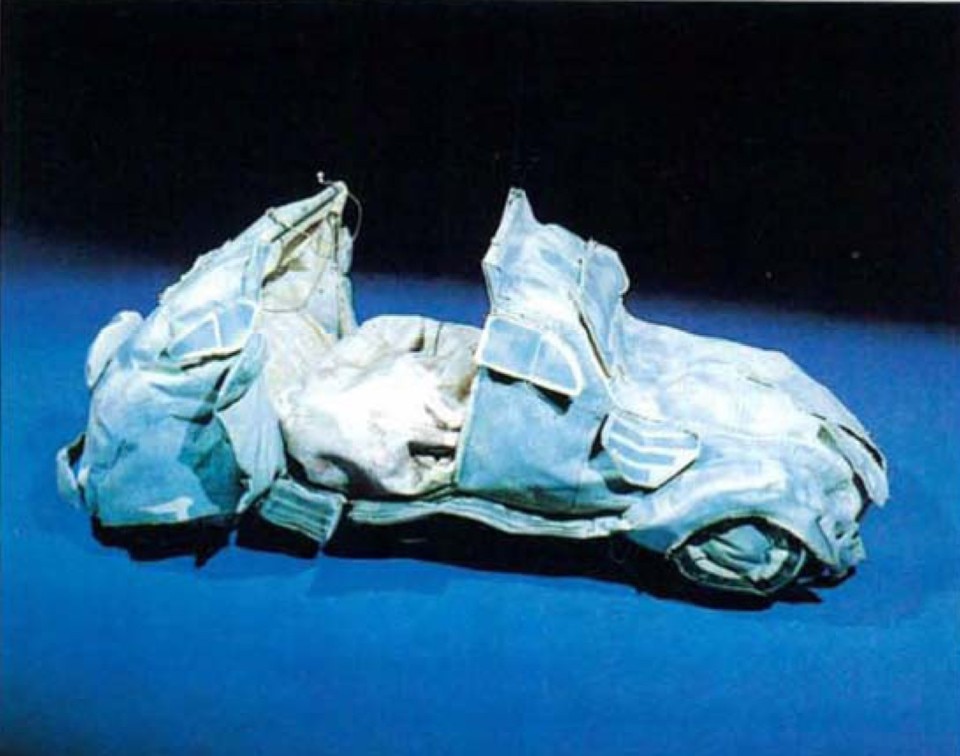
D.S Can you give me an example, in a diaristic sense, of a recent work that you’ve executed from beginning to end?
C.O We can talk about the “Alphabet”. “The Alphabet” begins in 1970 as a drawing. Every work has a long story connected with it. I did the drawing because I got off a plane that was headed for Cleveland that I thought was not going to make it, so I decided to get off the plane, and I went home and started to draw to pass the time, and I drew this “Good Humor Alphabet”... There was an ice storm and the plane was sitting on the ground for four hours and the wings were covered with ice, and I sat there and decided that I had to get off this plane and they said you can’t get off this plane now, and I said if you don’t let me off the plane I’m going to cause a terrible scene and frighten everyone. And they said OK we'll let you off, so I got off, but by the time I got back to New York the plane had landed in Cleveland so it was nonsense. But this created three of four days in which nothing had been planned.
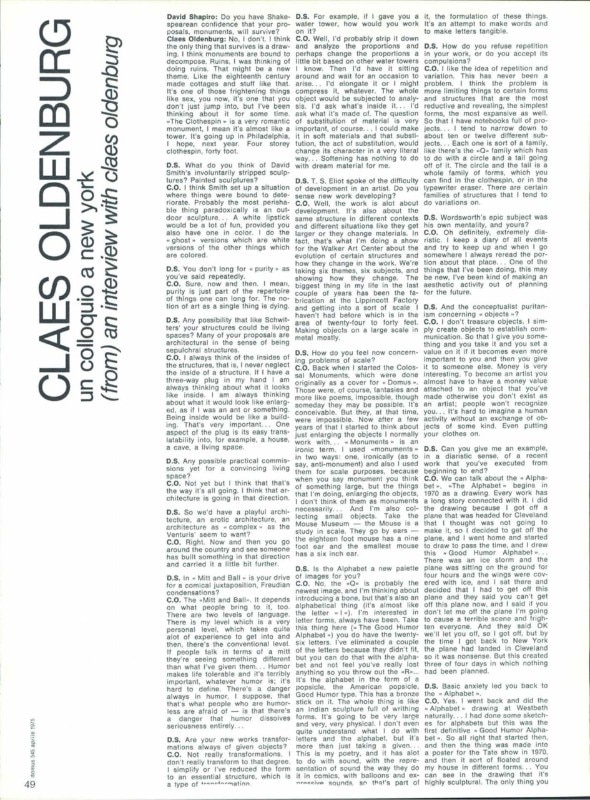
D.S. Basic anxiety led you back to the “Alphabet”. C.O. Yes. I went back and did the “Alphabet” drawing at Westbeth naturally... I had done some sketches for alphabets but this was the first definitive “Good Humor Alphabet”. So all right that started then, and then the thing was made into a poster for the Tate show in 1970, and then it sort of floated around my house in different forms... You can see in the drawing that it’s highly sculptural. The only thing you can't see is tne other side. So then I had a chance in 1972, I was introduced to Michael Crichton, the writer of science fiction and a client of Margo Leavin's, she's a dealer out on the West Coast in Los Angeles, and he wanted the sculpture for his garden... The question was what should he have. Now he had been a doctor, and he had been a writer, and this influenced him. First he wanted to have a “Soft Typewriter” which didn't really lend itself to a monumental developSoft Typewriter.. 1963 ment... He wanted something erect, standing up. He's seven feet tall exactly. He owned a reproduction of this drawing and he said why not make a Good Humor Alphabet” for my yard. And I said that's an excellent idea. I've just been waiting for someone to say that. So that was in 1972 and now it's two years later, and it has been in the works... It's typical of my works that the techniques are not exactly predetermined. They have to be worked out and adapted to the image... This is a garden sculpture for Crichton. The way we worked it out is that I had this blowup made, this blowup is put on a table and these letters are all traced out and it's put together like a jig saw puzzle. Each one of these letters is made individually, and it's taken off the original which I made.
D.S. Those are the discrete atoms of the work.
CO. Yes. I went out to California and spent three weeks making a final plaster model which had been prepared for me in New York by a woman who works on ceramics. We had worked on a clay model first, and then we cast it into plaster. Then I carved the plaster model, then I enlarged the plaster model in a photographic blowup, and they take it from there, and they make individual letters based on my plaster model. It's made out of green urethane foam. It really looks great. It looks like it's a plant of some kind. And this is very typically Los Angeles manufacture as opposed to what goes on at Lippincott. The things are all standing around in individual letters, very nice all by themselves and then they just put them all together... They glue them together with epoxy and eventually the whole thing is coated with what's known as a jell coat which makes it very shiny and hard. And then after the thing has been made (that will be the positive) then that will be cast, the negative will be taken off that and then the thing will be recast in an edition of two. And Michael will get one, and I'll get the other one. Itili be mounted on a bronze stick, and it'll also be turnable so he can turn it (it has two sides now). I had to draw, make another side so that he can turn it.
D.S. Now, context is something you “like”. You once said of the “Trowel” that since it was completely manufactured you wanted it in a rural setting. Can you imagine an optimum context for the “Good Humor Alphabet” aside from the garden?
CO. Yes, I would put it on Park Avenue!
